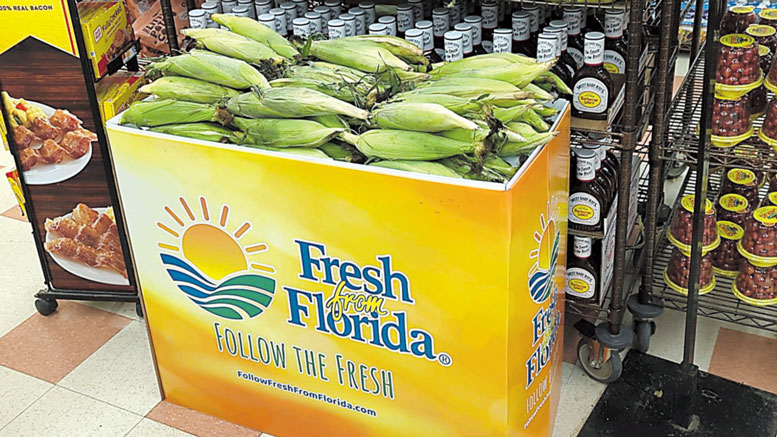Sweet Corn: Anchor for Summer Grilling
June 3, 2024 | 8 min to read
As spring approaches, sweet corn becomes a staple in grocery stores, often paired with summer grilling essentials. Retailers are encouraged to offer both shucked and unshucked options to cater to diverse customer preferences, enhancing their displays with recipe ideas. Sunshine Sweet Corn Farmers of Florida is hosting a "Comin' In Hot" display contest to promote fresh corn. With strong availability, especially from Florida, retailers should prioritize volume and effective merchandising to meet consumer demand.

This traditional favorite signals spring is here, with summer around the corner.
Originally printed in the May 2024 issue of Produce Business.
Nothing says grilling like a classic pickup truck filled with a load of fresh sweet corn parked in the produce department.
The corn draws attention as one of the bargains in the store, but the cash register ring grows profitable when you add tomatoes, squash and peppers next to the corn, and the steak, chicken, and fish a few feet away.
The only questions for retailers are whether the corn should be shucked and wrapped, or should the corn be displayed with the shucks still attached. There is also the question of whether to display yellow, white or bi-color corn. The answer to both questions is yes.
Some customers prefer to see the corn shucked in a shrink-wrapped package with four ears, while others like to see the corn with shucks. It is wise to offer both.
“Bulk corn and tray pack corn both play an important role in the produce department,” says Tori Rumenik, executive director of Sunshine Sweet Corn Farmers of Florida, Maitland, FL. “For folks who want to pick out and shuck their own corn, we encourage bulk displays with fresh corn in a green husk. For customers who want to buy their corn already shucked, tray pack is a good option for them. Providing both options ensures consumers can choose based on their preferences.”
This year, the Sunshine Sweet Corn Farmers of Florida is holding its first contest for the best retail display from early April to late May. The “Comin’ In Hot” theme highlights sweet corn from Florida is fresh and ready for customer-favorite recipes, like Mexican street corn, spicy corn and radish relish and hot jalapeño corn dip.

PHOTO COURTESY FLORIDA DEPARTMENT OF AGRICULTURE AND CONSUMER SERVICES
“The Comin’ In Hot display contest through Sunshine Sweet Corn is a wonderful way for retailers to cross-merchandise sweet corn with flavorful recipe additions,” says Rumenik.
“Sweet corn is typically either bought because it is on a recipe list for that week or on impulse because it looks great in stores. Retailers can improve these displays by including recipe ideas along with their displays,” Rumenik explains.
In retail displays, Rumenik recommends keeping the corn in a cool area with ideal moisture levels of 95%. “Corn would ideally be displayed in a refrigerated area or rotated back into a cooler for overnight storage if it is part of a creative display. If the corn looks dry, retailers are encouraged to rotate in fresh corn. We want to make sure we keep customers excited about buying sweet corn by displaying a quality product.”
While it is wise to offer both shucked and unshucked sweet corn to accommodate consumer differences, retailers can decide which ratio to offer depending on which is flying off the shelves.
“Some retailers shuck it themselves to save money,” says Royce Greenfield, sales manager at Greenfield Fresh, Redding, CA, who has sourced and shipped dozens of vegetable and fruit varieties since the beginning of this century.
MERCHANDISING
There are many places to display sweet corn within the produce department. “As summer goes on, you put the sweet corn next to the watermelon, cantaloupe and stone fruit,” says Greenfield.
Even before the summer fruit arrives, there are opportunities to use sweet corn as the center of merchandising for grilling.
“Particularly in the spring and summer months, any items that remind people of grilling and being outside and enjoying the weather can be a good cross-merchandising opportunity,” says Bill Nardelli Jr., vice president of sales at Nardelli Brothers, Inc.-Lake View Farms, Cedarville, NJ.
“Items that remind people of grilling and being outside and enjoying the weather can be a good cross-merchandising opportunity.”
— Bill Nardelli Jr., Nardelli Brothers, Inc. – Lake View Farms, Cedarville, NJ.
“Corn can be positioned near the meat section in displays capitalizing on the grilling items, such as hot dogs and hamburgers. There is also an opportunity with other produce items, including melons, cantaloupes, honeydew and summer fruit and vegetable items,” he says.
Nardelli Brothers ships more than 80 fresh produce items to locations east of the Mississippi from fields in New Jersey.
Nardelli says consumers look forward to the big open displays of corn in the spring and summer. “Some of our retail partners will open their doors as the weather gets warmer, specifically in the Northeast and Midwest after a long winter,” says Nardelli. “This gets the consumer in the mind of warmer weather items, and corn is always first on their minds.”
There are opportunities to promote corn in the winter months as well. “During the winter, we see an increase in tray-pack corn consumption, as consumers are looking for more value-added options,” Nardelli says.
There have been more dishes that utilize corn, particularly soups and dips, he adds. “The avocado industry has capitalized on Super Bowl promotions for guacamole. There is a similar opportunity in corn, as many of the corn dips and street corn have become popular at parties and game day events.”
There are countless cross-merchandising opportunities for sweet corn.
“Add bell peppers, tomatoes, and onions to the display for a sweet corn salsa or Tajin and cotija cheese for some great Mexican street corn,” advises Rumenik.
She also says Cinco de Mayo is in the middle of the Florida sweet corn season and offers a lot of opportunities for cross-promotion. “Remember that spring sweet corn can be used for so many recipes and most don’t require a grill. One of my favorite ways to prepare sweet corn is to pop it in the microwave for 90 seconds and then add it to my recipe or my meal prep for the week.”
AVAILABILITY IS STRONG
Regional grower-shippers supply local sweet corn to every area of the country.
“Florida’s biggest volumes of sweet corn are during the spring months of March, April and May,” says Rumenik. “We also have Florida sweet corn starting in November and through the winter, but most of the promotable volumes come in the spring.”

PRODUCE BUSINESS/AIMEE TENZEK PHOTO
Rumenik says the East Coast crop moves into Georgia in May and then further north in subsequent months. “California is also a large domestic producer of sweet corn, but their product typically stays in the western states while Florida’s sweet corn stays east of the Mississippi River.”
The Florida crop should get sweet corn off to a tasty start this year. “We have a gorgeous crop this year,” says Rumenik. “We had a little bit of a slower start because of rain skips from the fall and winter, but yields and weather are improving. I took some home last week, and it was some of the sweetest corn I’ve had since last spring.”
The Northeast sweet corn harvest comes later in the summer.
“The prime time for promoting corn typically begins in April with Florida spring harvests beginning to kick in and volume increasing. Through April and May, we have promotable volume of spring corn from Florida harvest on all flavors, as well as our tray pack offerings on yellow, white and bi-color corn,” says Nardelli.
“Beginning in June, we will begin Georgia corn harvest. From July through October, we will be harvesting at our home farm in Cedarville, NJ, on all the three bi-colors, yellow and white, as well as our Wild Violet corn that we do in New Jersey beginning in July.”
Greenfield Fresh does not grow sweet corn, but sources and ships it from western farms over an extraordinarily long season.
In the early spring, the company was shipping sweet corn grown in Mexico and entering the U.S. through Nogales, AZ, according to Greenfield. Greenfield’s California season starts with product from the Coachella Valley in mid-April, weather permitting. Greenfield then follows the crop north to the Huron and Mendota areas of the Central Valley. Greenfield’s season ends with sweet corn from Dixon and Brentwood in the greater Sacramento and San Francisco Bay areas.
There are regional differences in consumer preferences among sweet corn varieties.
“Depending on the area in the country, you can see different preferences for all three of the main flavors,” says Nardelli. “The Northeast prefers primarily bi-color corn, as well as the Midwest. Some areas in Pennsylvania, Maryland, Delaware, and parts of New Jersey are preferential to white corn. The Mid-Atlantic and parts of the South use both yellow, as well as bi-color.”
Whichever strategic cross-merchandising location is used, and whichever ratio of shucked or not, sweet corn is the prime example of the “pile it high, and watch it fly” strategy.
“Volume, volume, volume,” suggests Rumenik. “If you are promoting sweet corn in circulars or on the produce floor, look to promote multiples like five and six ears of corn instead of one or two ears.”
• • •
Branch Farms Unveils a New Sweet Corn Variety
Branch: A Family of Farms, South Bay, FL, launched Sweet Scarlet, a unique addition to its lineup of premium sweet corn varieties.
Developed through breeding practices through seed developers at the Crookham Company, Sweet Scarlet embodies a fusion of taste and vibrant red color.
Sweet Scarlet maintains the familiar texture and taste of traditional sweet corn, making it a versatile choice for any application.
Sweet Scarlet launched at select retailers in late April.

